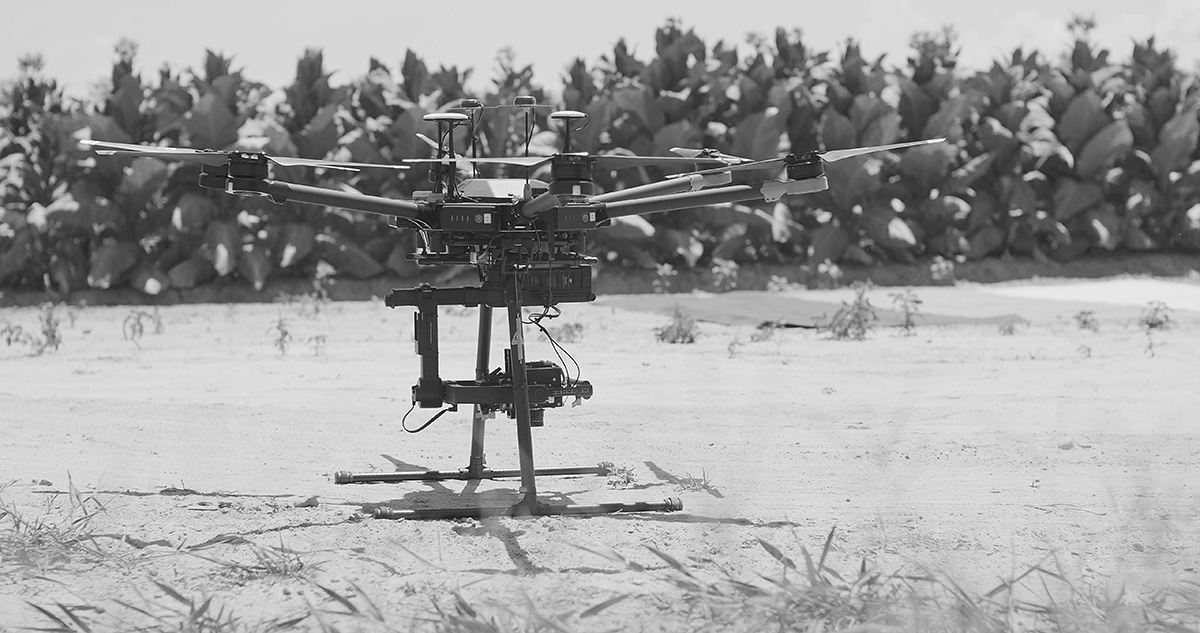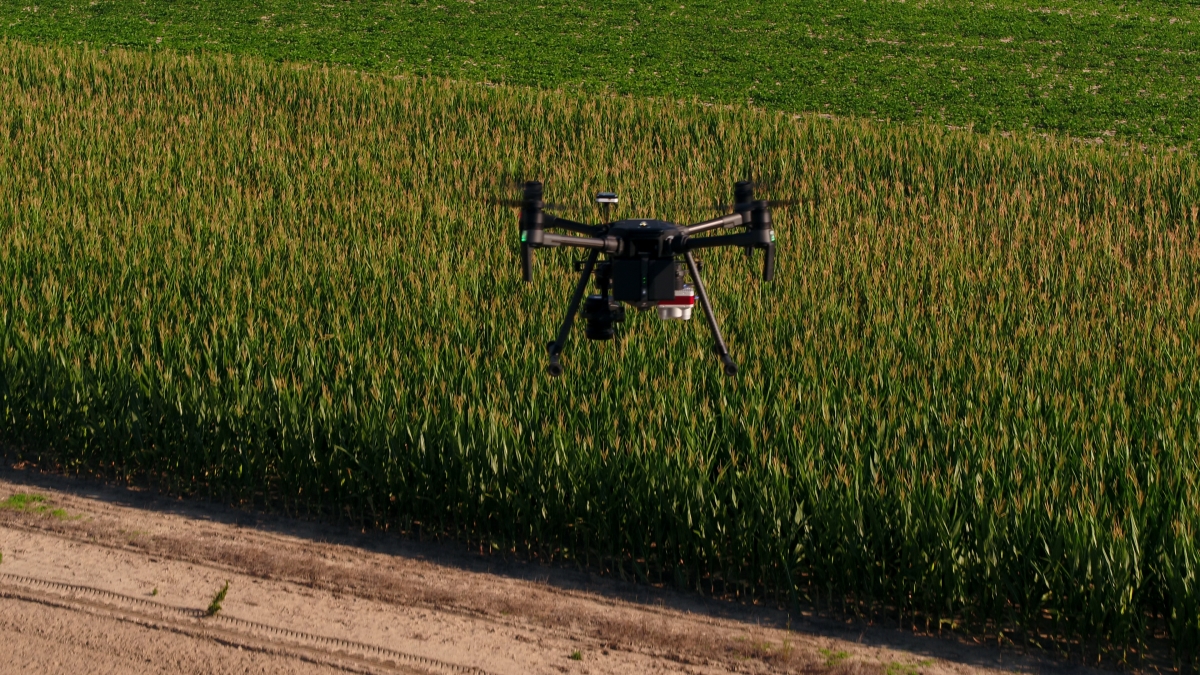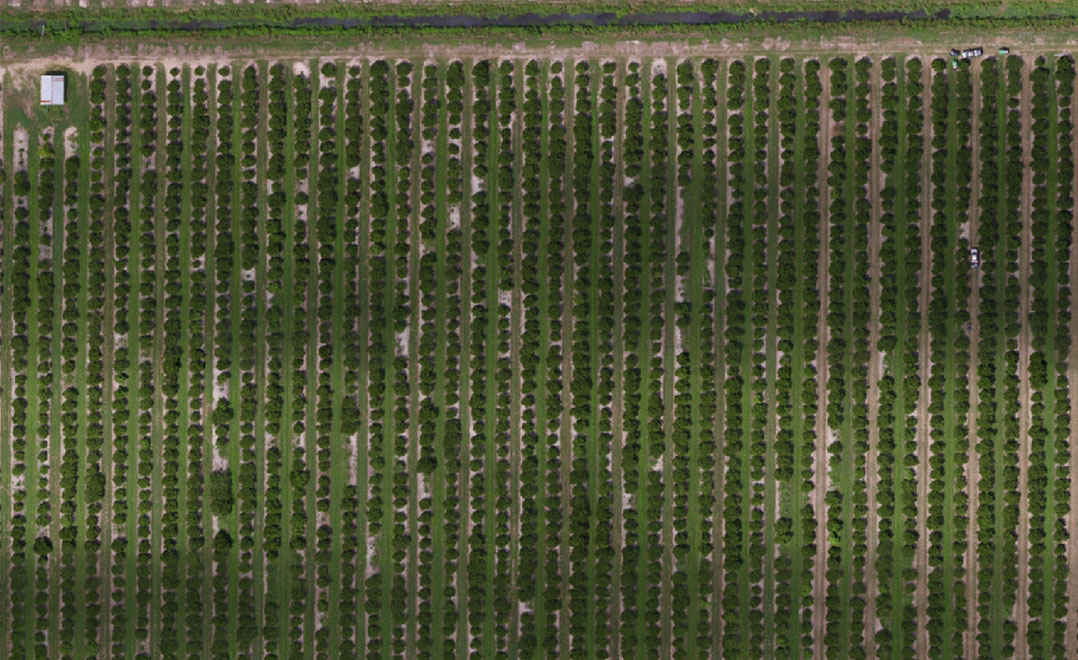More than 80 percent of the world’s almond supply and 99 percent of walnuts grown in the U.S. come from California. But heatwaves and droughts remain a persistent threat to the health of almond and walnut yields. A recent four-year drought in California caused almond outputs to decrease by nearly 2 billions pounds per year. By using drones and precision agriculture to better manage irrigation and nutrient inputs during times of plant stress, fruit and nut farmers are optimizing the health of their yield.
Growing walnuts, almonds, hazelnuts and other nut varieties is high-cost, with potential high profits if the orchard produces consistently healthy yields. But seasonal weather patterns such as damp and hot springs can create the ideal breeding ground for disease such as almond anthracnose and crown gall have long been the primary threat, while an early frost can cause a young tree to die back to its roots. With the average nut tree taking five years or more to develop before bearing healthy fruit, it is essential to mitigate the risk of disease, seasonal weather damage, and extreme weather damage, such as drought, to maximize profits. WIth the help of drone-based analytics, orchardists can detect diseases early enough to mitigate the risk of damage to surrounding crops. They can also avoid sunburn, dehydration and freeze damage by better managing nutrient inputs at high-risk times of the year.
By maximizing the number of healthy, nut-bearing trees with the help of PrecisionAnalytics, farmers can maximize their yield potential, and profits. By applying analytics to aerial imagery, orchardists may count and size trees in a given zone or field, and identify signs of heat stress, vegetation overgrowth, and disease. Following a storm, they can also use drones to collect imagery of the damage to ensure accurate crop insurance payouts.
Regardless of whether or not a grower has implemented precision agriculture on their farm, there are many ways they can use drone-based aerial intelligence when managing nut trees. Drone-based crop scouting and precision management are supplanting time-intensive and error-prone traditional methods such as ground-based sampling and satellite imagery for:
- Crop scouting: drones enable farmers to save time by scouting an entire nut grove in a matter of hours, capturing high-resolution imagery and delivering near-instant data turnaround.
- Counting: farmers can use drone-based data to quickly and precisely count trees, capturing more detailed imagery on singular trees than satellites can.
- Sizing: aerial imagery and analytics enable farmers to precisely track tree size across the season and growth years to determine tree age, vigor, and the location of newly planted trees.
- Managing inputs: monitor tree health, vigor, and look for early signs of stressors such as sunburn or freeze damage, yellowing or browning leaves, or watery lesions, using vegetative indices.
- Mapping the field: learn more about the topography and soil type of different zones in your field and better manage irrigation and fertilizer inputs at high-risk times of the season or during drought.
- Maintain documentation: track and store records of seasonal production and yield health in the cloud to easily reference in case of an insurance or food safety audit.
Using precision agriculture drones to capture high-resolution data as they fly, farmers can get an accurate count and size comparison throughout the season. With near-instant multi-sensor imagery and analytics, orchardists can make more informed decisions to manage nutrient inputs and fortify their trees against damage and disease. Ultimately, farmers maximize their profitability by using this information in making more efficient and effective input and inventory decisions.
Read on to learn how PrecisionHawk is helping nut orchardists make more informed management decisions and improve the health of their trees.
Collect High-Quality Nut Tree Data
At PrecisionHawk, our goal is to help orchardists accelerate and streamline the work of data collection, analysis and reporting. Because nut orchards are often grown on a scale of hundreds to thousands of acres, farmers can optimize their data collection by gathering more imagery in fewer flights. Farmers can capture mature nut trees at altitudes as high as 80 meters, covering more terrain in less time, while still getting highly accurate data--on a field, a row, or an individual tree. If a farmer spots an issue on the map, they can collect high-resolution photos of individual trees to investigate further.
For tree count and inventory, farmers can start with multirotor DJI Phantom 4 or DJI Mavic drones outfitted with RGB sensors. Those seeking more precise health indicators in their groves can use a multispectral sensor, such as the DJI M200 drone equipped with a MicaSense RedEdge-MX or MicaSense Altum sensors to capture thermal or near-infrared imagery. MicaSense’s sensors are purpose-built for precision agriculture. By capturing very narrow spectral bands, between 10-40 nanometers wide, they’re able to detect subtle deviation in leaf color throughout the growing season. They can easily identify fading caused by watery lesions, or leaf browning, a common symptom of stress or lack of nutrition. That means these sensors can help orchardists detect even more nuanced information about nutritional inputs, stressors, and potential disease affecting their trees.
The entire process of data collection and analysis is cloud-based, enabling a smooth transition from capturing data in-field, to analyzing and actioning results. Using PrecisionAnalytics, farmers can upload information about different farms, name different fields, and even import their GPS coordinates to geolocate themselves in relativity to the field.
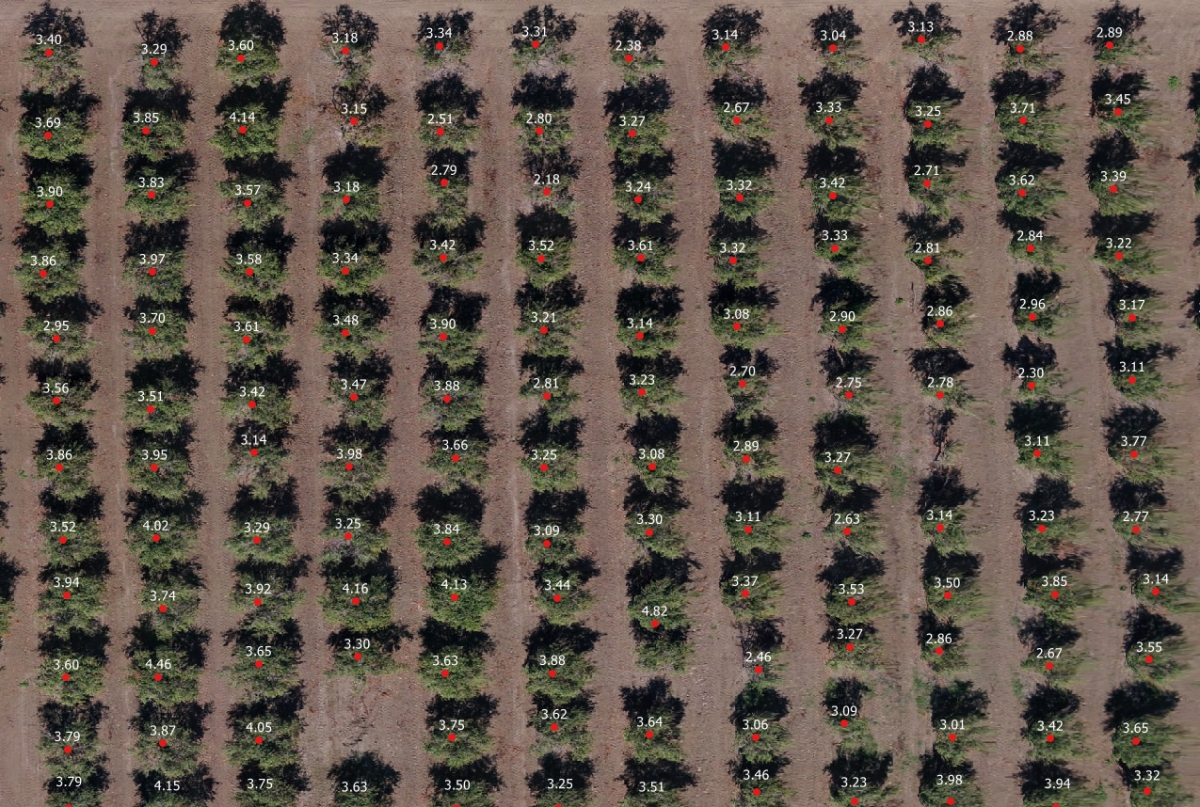
Process & Analyze
PrecisionAnalytics Agriculture is a complete aerial mapping, modeling, and agronomy platform based on 10 years of agriculture analytics experience and millions of acres of farm data. The system automatically processes, organizes, and annotates geospatial data. It also applies machine vision to automatically produce rich data visualizations, as well as machine learning to surface trends and patterns in orchards.
In PrecisionAnalytics Agriculture, a farmer can monitor tree health, verify inventory, and run a myriad of other analytic reports within minutes:
- Crops at a glance: Review the overall health of orchards to surface issues related to aging, freeze damage or heat stress, flooding or dehydration, or disease.
- Detailed views: View full-resolution imagery and zoom in on health details of a single tree, taking analyses deeper than with satellite imagery.
- Geolocation: Quickly identify where an area of concern is relative to your position.
- Instant inventory and canopy sizing: Define an area and then quantify the number and size of trees within it. See the distribution of the age of trees across a field or zone.
- Vegetative Indices: Use indices like NDVI, GLI, and VARI to identify early indicators of and trends in tree stress. Use thermal indices to track soil moisture and heat stress.
- Zonal and plot statistics: Draw perimeters around problematic parts of the orchards, such as those that need irrigation management, by creating automatic and custom-defined plots. Or compare the performance of different crop varieties.
- Comparison view: View multiple datasets at a time to analyze trends in tree growth over time.
- Multi-farm and -field management: Navigate all properties and associated data in a single, streamlined portal.
Vegetative Indices
One of the most pressing diseases affecting walnut trees in particular, crown gall, is difficult to diagnose in younger trees using traditional ground-based inspections. Typically, crown gall only becomes apparent once the soil-based bacterial infection has spread enough to stunt the tree’s growth or cause early fall coloration. However, vegetative indices like NDVI, collected with near-infrared RGB sensors, point to trends in plant stress such as yellowing or loss of green vigor. Thus, orchardists can identify early signs of disease such as browning or early “fall” coloring, and dry soil and ground cracking around the trunk of the tree, which the human eye might not catch. As galls grow and impact tree roots, eradication becomes more difficult. By identifying signs of the disease earlier, orchardists can then make more efficient decisions on removal, or whether to replant the tree entirely.
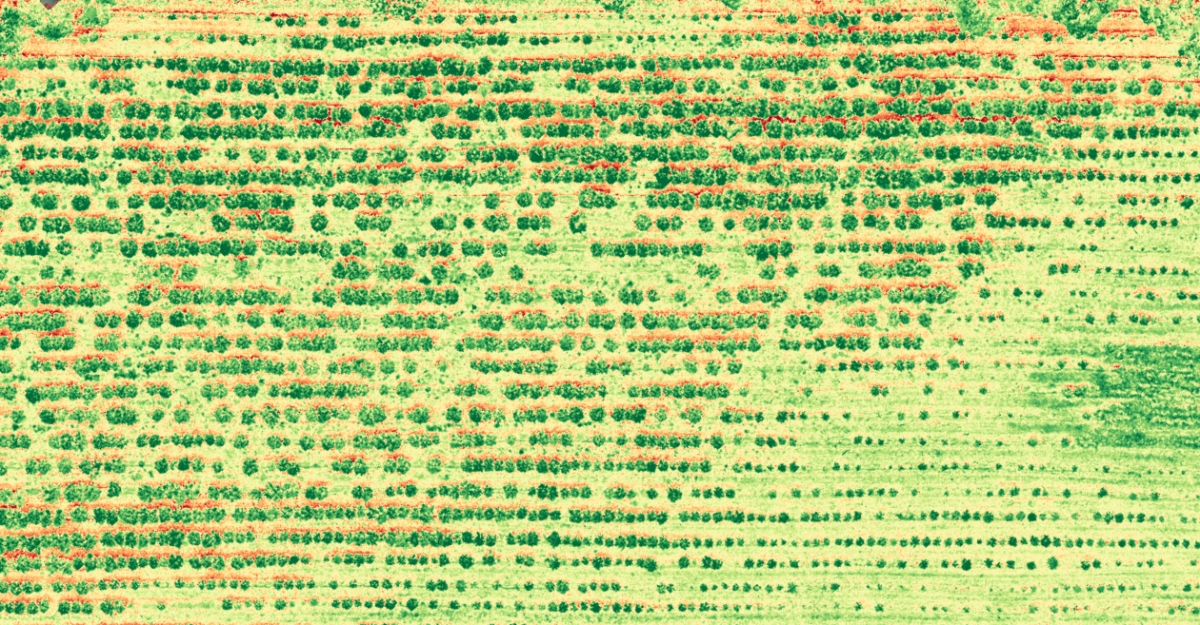
Since NDVI, VARI and GLI indices applied on a plant-by-plant or zonal basis can catch slight discrepancies in leaf vigor, nut farmers can use these indices to catch early signs of autumnal leaf browning and take steps to prevent frost damage. Newly-planted trees are particularly vulnerable to freeze damage, which can cause young trees to die back to roots. To minimize freeze damage, farmers can adjust fertilizer and irrigation inputs so that the tree ceases to produce new buds for the season. Combined with thermal indices that can track heat stress and moisture levels, these indices can be used to determine when to stop applying fertilizer and withhold irrigation in order to encourage terminal bud setting. This enables farmers to manage plant inputs and take steps to prevent fall freeze damage. As a result, the trees will be better prepared for winter and to continue growing in the spring.
In the summer, trees may become sunburned in temperatures of 100℉ or more, which would cause the fruit to shrivel and blacken. Nut farmers can use thermal indices to identify heat stress in a plant and adjust irrigation inputs accordingly. Thermal indices applied over plant data collected during the heat of the day can indicate where the plants and soil are cooler, indicating sufficient levels of moisture, and where signs of heat stress are indicating lack of moisture. As a result, farmers will know where to increase irrigation, and can monitor the health of the plants until the weather cools down.
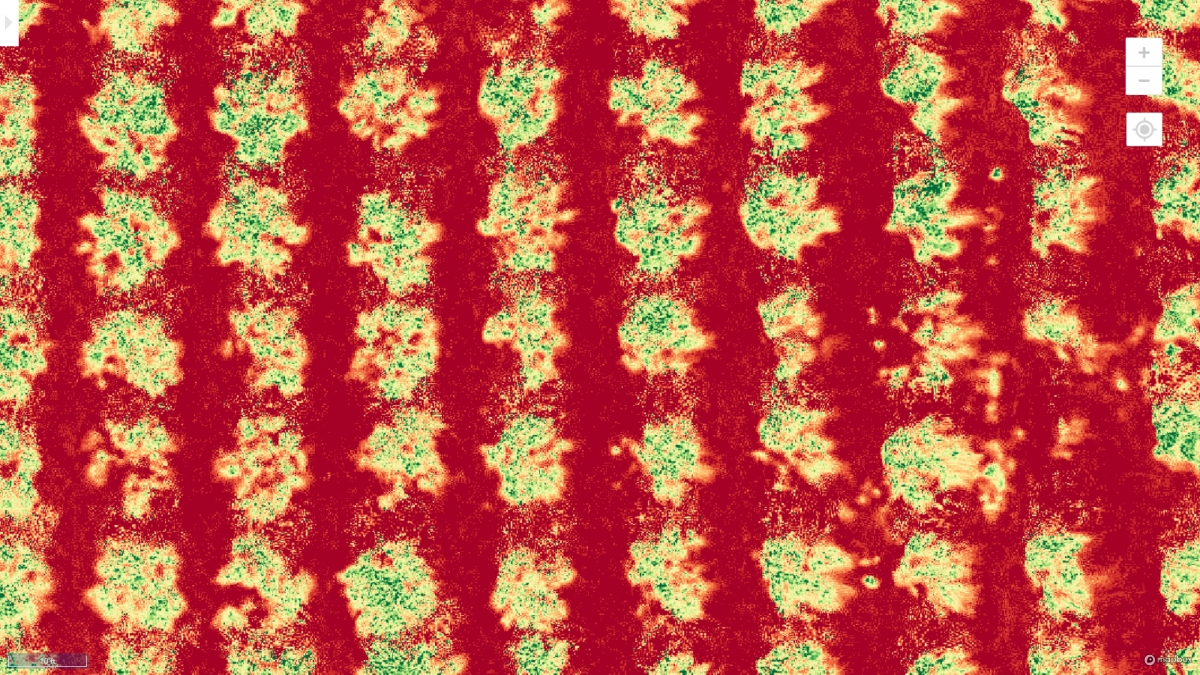
Custom Manazement Zones and Comparison View
Diseases such as crown gall and almond anthracnose spread easily under the right conditions, threatening the health of a yield. After identifying early signs of disease with vegetative indices, users can then use custom zone management tools to quarantine and isolate individual trees or rows of trees that are infected. With the infected zones easily identified, users can take steps to mitigate the potential for spreading the disease to uninfected areas, such as: managing farm machinery and pruning tools, and managing irrigation inputs--especially for fungal diseases like anthracnose, which thrive in wet environments. As a result, farmers can mitigate the spread of damage and protect the rest of their trees.
Users can then track these zones during the growing season. At the end of a season, they will be able to compare zones over multiple periods and determine how successful they were in stemming the spread of disease. They can compare yields from trees in quarantine zones and healthy zones. If necessary, they will see where they should consider replanting for the next season in order to recover any lost yield. Ultimately, it enables growers to make more informed decisions and protect their profit margin.
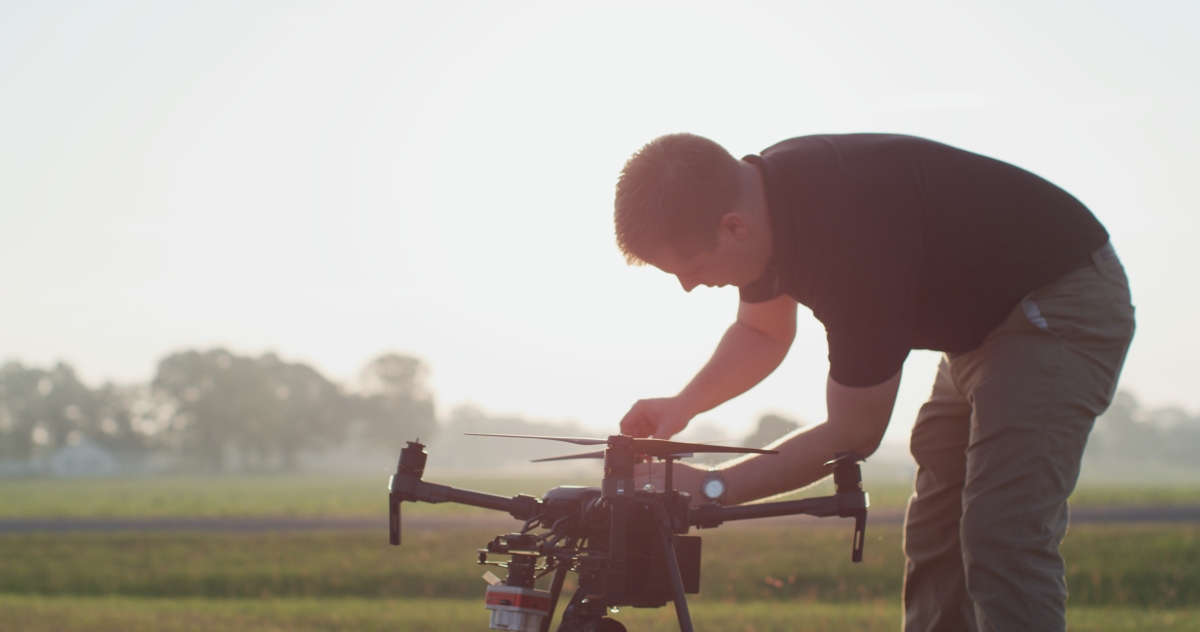
Why PrecisionHawk?
In California, where drought is threat never far from reality, nut farmers must optimize crop management and ensure healthy yields. Since an average acre of nut trees costs over $4,000, the trees should produce healthy looking yields consistently for several years in order to maximize profits. Despite consistent threats from disease and seasonal weather damage, orchardists are using precision agriculture drones to gain a more intimate understanding of their trees and make more efficient nutrient management decisions. At PrecisionHawk, we’ve designed our cloud to turnaround high-resolution imagery and analytics in near real-time, and our robust yet flexible machine learning-based algorithms are designed for counting and sizing tree canopies, and identifying changes in leaf vigor.
Our data scientists have built on years of experience collecting data over orchards and using aerial mapping to scout trees, and have developed some of the best-trained machine learning models in the industry. From our basic plant count tool to our in-depth vegetative indices, our algorithms are better able to detect individual crops and deliver precise analytics about count, sizing, and health based on terabytes of data across a wide variety of crops and soil types. Additionally, our years of working with leading agronomists have informed our intuitive framework, built for multi-field and multi-form data management and sharing. As a result, farmers can learn how successful they were in cultivating nut varieties from season to season.
We’re here to help you adopt smarter and more efficient farming practices. Our agricultural experts will assist in evaluating when, where, and how to incorporate drone-based aerial intelligence into your operations. Our global network of drone operators is ready to execute flights on your behalf. And our engineers are continuously optimizing PrecisionAnalytics Agriculture to better automate and accelerate your analysis.
Contact us today for more information on how you can use drone-based aerial intelligence in your operations.
